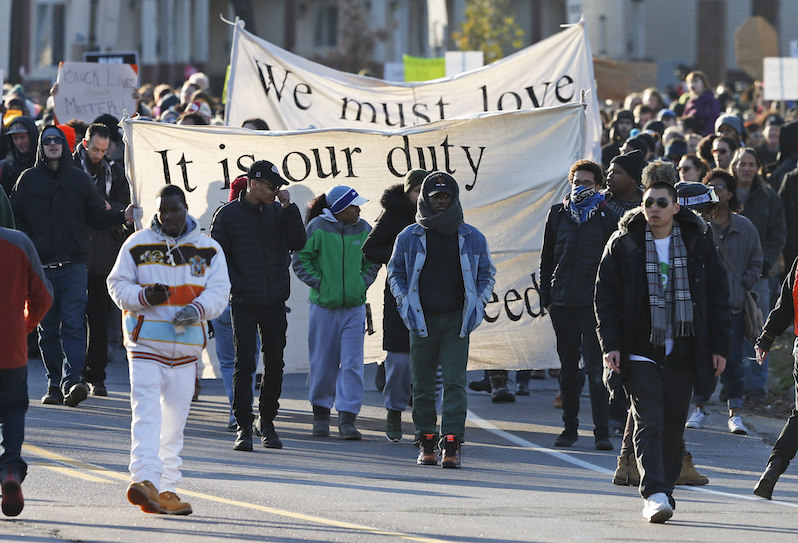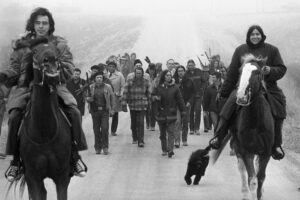Why Black Lives Matter Is the Movement of the Year
The movement's innovative and committed activism has renewed the struggle for racial justice In 2015, no other progressive cause in the United States came close to its perseverance and creativity The movement's innovative and committed activism has renewed the struggle for racial justice. Black Lives Matter activists march in Minneapolis in November. (Jim Mone / AP)
1
2
Black Lives Matter activists march in Minneapolis in November. (Jim Mone / AP)
1
2
A compilation of eloquent responses to the standard complaints against BLM in The Huffington Post included this one that Ramirez and her ilk ought to read:
What they say: “I’m fine with protesting, but why don’t they protest in front of a police station or another approved location instead of blocking traffic?”
What we hear: “I’m fine with protesting, as long as I’m not forced to see it, hear it, acknowledge it, be at all inconvenienced by it or challenged to do anything about it.”
The Christmastime protests were not restricted to Minneapolis. There were BLM demonstrations in cities across the nation, including San Francisco and Los Angeles. That so many people took time away from family and community in order to protest racial injustice is a testament to the serious commitment of the movement’s activists, several of whom were arrested during BlackXmas actions and spent Christmas in jail.
There are two Americas when it comes to police brutality and racial justice — the one that blacks experience and the one that whites experience. (Nonblack people of color occasionally get the former or latter experience, depending on circumstance.) What the past two years have shown us is that killings of African-Americans by police is continuing to happen, continuing to be recorded, continuing to be protested and continuing to be condoned by a justice system hellbent on absolving the killers of black folk. It has also shown us that the movement that this injustice has spawned is shrewd, adapts quickly and is here to stay.
Although American society’s response to BLM protests has not been strong enough to bring about any real justice yet, there have been some measurable successes about which the movement can rejoice. Chief among them is that mainstream commercial media have been forced to acknowledge BLM’s importance. Cosmopolitan magazine — not exactly a liberal or even political rag — glowingly profiled the three female co-founders of BLM this October. The New York Times, in a recent editorial, cited BLM as one of the “Moments of Grace in a Grim Year,” saying the “movement spread a message of peaceable resistance.” And CNN published a lengthy chronicle titled “The rise of Black Lives Matter: Trying to break the cycle of violence and silence.”
There is evidence that the movement has even caused news institutions to adjust their coverage to focus more on institutionalized racism. Earlier this year, the Los Angeles Times hired a reporter to cover Black Twitter, which is very telling given that most prominent BLM activists are extremely active on social media and have used it as an effective tool to spread their message. The Times is even hiring a national “race and justice” writer to cover “the deaths of African Americans at the hands of police” and “the sudden prominence of the Black Lives Matter movement.” Many movements of the left have struggled for years to get the type of media recognition that BLM’s hard work has yielded.
The movement has also influenced the presidential race with its early tactic of confronting the most liberal candidate in the Democratic nomination race, Bernie Sanders, followed by encounters with other candidates. The Washington Times, a conservative paper, has acknowledged how Black Lives Matter has “forced all three candidates to change their strategies when discussing race relations and appears to have influenced their policy platforms, with each increasingly focusing on criminal justice reform, police brutality, equal employment opportunities and other issues.”
Sanders even said of Bland: “There’s no doubt in my mind that she, like too many African-Americans who die in police custody, would be alive today if she were a white woman.” It is unlikely that Sanders, who started out focused mostly on economic justice issues, would have made such a statement were it not for BLM’s relentless and unforgiving activism aimed at his campaign.
To be sure, the movement has its critics, especially those who worry that it didn’t confront Hillary Clinton as much as it confronted Sanders. Some also see the fact that it is a loosely organized movement, without clear leaders, as a weakness. But compared with Occupy Wall Street — the last high-profile progressive movement — BLM has managed to achieve a great deal, including making its leaderlessness a strength.
As long as black people continue to be killed by police and the responsible police officers continue to go free, Black Lives Matter is not going anywhere. Of all the activist movements deserving of recognition at the end of 2015, BLM emerges as a clear leader.
Your support matters…
SUPPORT TRUTHDIG
Independent journalism is under threat and overshadowed by heavily funded mainstream media.
You can help level the playing field. Become a member.
Your tax-deductible contribution keeps us digging beneath the headlines to give you thought-provoking, investigative reporting and analysis that unearths what's really happening- without compromise.
Give today to support our courageous, independent journalists.






You need to be a supporter to comment.
There are currently no responses to this article.
Be the first to respond.